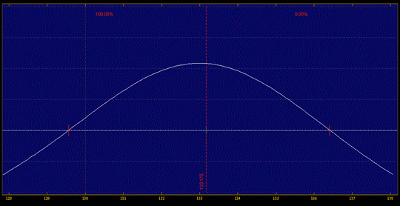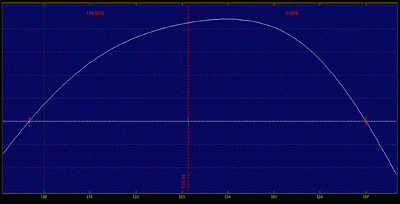Four specific steps can be combined to produce a reliable and successful calendar spread strategy that works each month and in all types of market conditions.
In a discussion I’ve been having with other volatility traders on LinkedIn, I’ve been trying to get the point across that a properly constructed and hedged calendar spread portfolio won’t exhibit the “exploding Gamma” (their words, not mine) one sees in a single, one-strike calendar spread as expiration approaches.
(For an understanding of what Gamma is, click here.)
This made me realize that a lot of options traders—including many very intelligent, seasoned veterans—still hold fast to that myth. A solid calendar option strategy combines staggered entries and a variety of hedging techniques to control not just Delta, but Gamma and Vega, as well.
How It Works
Say you enter the SPY June/July 133 calendar spread today. The graph of profit/loss versus underlying price on the Tuesday before expiration would look something like this:
Gamma, in proportion to capital at risk (assuming you’re lucky enough that SPY is priced near $133 at the time), would be nearly -12%. Not good. So how do we avoid this unstable risk profile?
Step One
Start out with double calendars. The graph below shows the risk profile for a double-calendar that our strategy rules would have us enter today (if we weren’t already in the two June positions we currently have open).
It might not be immediately apparent, but the proportional gamma of this position is only about -2%—that’s less than one-sixth the Gamma of the single calendar.
NEXT: See the Next Steps for Winning Spread Trades
|pagebreak|Step Two
Build up your calendar portfolio over time, using new entries to spread out risk as the market moves. We don’t just pile all of our capital into a double calendar and hope for the best; we start out using a fraction of what we want to allocate to our calendar spread portfolio and add positions that offset our Delta (and, ideally, Gamma) risk if the market moves more than a certain amount up or down. (If SPY trades sideways for a few weeks, we can make 30%, or about 7% of our total allocation, on a single trade.)
What we end up with, assuming the S&P doesn’t just float along sideways for the entire month, is a portfolio of calendar spreads distributed across a wide range of strikes. To get the visual, imagine the double-calendar risk profile shown above spread even wider. Our negative Gamma per dollar at risk is even smaller, and if we play our cards right, it actually will shrink into expiration.
That’s not to say we want to keep our positions open right up to expiration—there are numerous reasons we want to flatten out as early as possible, which brings us to step three.
Step Three
Begin taking off risk no later than a week before expiration. There are times when we stretch the limits of this rule (May was especially vexing, with forward volatility skew persisting into expiration week), but we typically take off the position with the most negative Gamma by the Friday preceding expiration Friday. (See related: Trading Options Expiration)
Step Four
Don’t buy volatility at a premium. This topic strays from my focus on Gamma, but it’s another crucial part of our strategy for managing calendar spread risk.
If the market is selling off and we need to reduce our Delta risk, we do it by opening a short-Vega position instead of another calendar spread. The details are exclusive, but the point is that the strategy includes techniques for hedging Vega, as well as Delta and Gamma.
I’ve presented the basic, high-level concepts of the calendar options strategy here in a nutshell to illustrate that the “conventional wisdom” about calendar spreads and how to trade them is sadly lacking.
By combining the four elements above, we’re able to trade a portfolio of time spreads every month (except when our volatility-risk gauge is triggered—but that’s a topic for a future post) and, over time, consistently outperform in up, down, or sideways markets.
By Frank Caruthers of Condor Options























